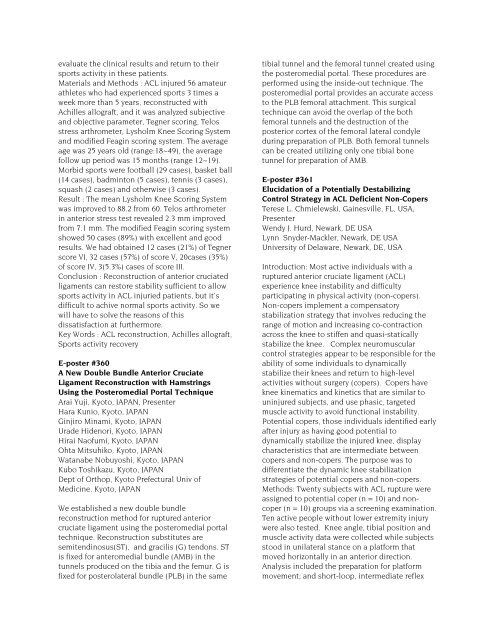POSTER ABSTRACTS - ISAKOS
POSTER ABSTRACTS - ISAKOS
POSTER ABSTRACTS - ISAKOS
Create successful ePaper yourself
Turn your PDF publications into a flip-book with our unique Google optimized e-Paper software.
evaluate the clinical results and return to their<br />
sports activity in these patients.<br />
Materials and Methods : ACL injured 56 amateur<br />
athletes who had experienced sports 3 times a<br />
week more than 5 years, reconstructed with<br />
Achilles allograft, and it was analyzed subjective<br />
and objective parameter, Tegner scoring, Telos<br />
stress arthrometer, Lysholm Knee Scoring System<br />
and modified Feagin scoring system. The average<br />
age was 25 years old (range:18~49), the average<br />
follow up period was 15 months (range 12~19).<br />
Morbid sports were football (29 cases), basket ball<br />
(14 cases), badminton (5 cases), tennis (3 cases),<br />
squash (2 cases) and otherwise (3 cases).<br />
Result : The mean Lysholm Knee Scoring System<br />
was improved to 88.2 from 60. Telos arthrometer<br />
in anterior stress test revealed 2.3 mm improved<br />
from 7.1 mm. The modified Feagin scoring system<br />
showed 50 cases (89%) with excellent and good<br />
results. We had obtained 12 cases (21%) of Tegner<br />
score VI, 32 cases (57%) of score V, 20cases (35%)<br />
of score IV, 3(5.3%) cases of score III.<br />
Conclusion : Reconstruction of anterior cruciated<br />
ligaments can restore stability sufficient to allow<br />
sports activity in ACL injuried patients, but it’s<br />
difficult to achive normal sports activity. So we<br />
will have to solve the reasons of this<br />
dissatisfaction at furthermore.<br />
Key Words : ACL reconstruction, Achilles allograft,<br />
Sports activity recovery<br />
E-poster #360<br />
A New Double Bundle Anterior Cruciate<br />
Ligament Reconstruction with Hamstrings<br />
Using the Posteromedial Portal Technique<br />
Arai Yuji, Kyoto, JAPAN, Presenter<br />
Hara Kunio, Kyoto, JAPAN<br />
Ginjiro Minami, Kyoto, JAPAN<br />
Urade Hidenori, Kyoto, JAPAN<br />
Hirai Naofumi, Kyoto, JAPAN<br />
Ohta Mitsuhiko, Kyoto, JAPAN<br />
Watanabe Nobuyoshi, Kyoto, JAPAN<br />
Kubo Toshikazu, Kyoto, JAPAN<br />
Dept of Orthop, Kyoto Prefectural Univ of<br />
Medicine, Kyoto, JAPAN<br />
We established a new double bundle<br />
reconstruction method for ruptured anterior<br />
cruciate ligament using the posteromedial portal<br />
technique. Reconstruction substitutes are<br />
semitendinosus(ST), and gracilis (G) tendons. ST<br />
is fixed for anteromedial bundle (AMB) in the<br />
tunnels produced on the tibia and the femur. G is<br />
fixed for posterolateral bundle (PLB) in the same<br />
tibial tunnel and the femoral tunnel created using<br />
the posteromedial portal. These procedures are<br />
performed using the inside-out technique. The<br />
posteromedial portal provides an accurate access<br />
to the PLB femoral attachment. This surgical<br />
technique can avoid the overlap of the both<br />
femoral tunnels and the destruction of the<br />
posterior cortex of the femoral lateral condyle<br />
during preparation of PLB. Both femoral tunnels<br />
can be created utilizing only one tibial bone<br />
tunnel for preparation of AMB.<br />
E-poster #361<br />
Elucidation of a Potentially Destabilizing<br />
Control Strategy in ACL Deficient Non-Copers<br />
Terese L. Chmielewski, Gainesville, FL, USA,<br />
Presenter<br />
Wendy J. Hurd, Newark, DE USA<br />
Lynn Snyder-Mackler, Newark, DE USA<br />
University of Delaware, Newark, DE, USA<br />
Introduction: Most active individuals with a<br />
ruptured anterior cruciate ligament (ACL)<br />
experience knee instability and difficulty<br />
participating in physical activity (non-copers).<br />
Non-copers implement a compensatory<br />
stabilization strategy that involves reducing the<br />
range of motion and increasing co-contraction<br />
across the knee to stiffen and quasi-statically<br />
stabilize the knee. Complex neuromuscular<br />
control strategies appear to be responsible for the<br />
ability of some individuals to dynamically<br />
stabilize their knees and return to high-level<br />
activities without surgery (copers). Copers have<br />
knee kinematics and kinetics that are similar to<br />
uninjured subjects, and use phasic, targeted<br />
muscle activity to avoid functional instability.<br />
Potential copers, those individuals identified early<br />
after injury as having good potential to<br />
dynamically stabilize the injured knee, display<br />
characteristics that are intermediate between<br />
copers and non-copers. The purpose was to<br />
differentiate the dynamic knee stabilization<br />
strategies of potential copers and non-copers.<br />
Methods: Twenty subjects with ACL rupture were<br />
assigned to potential coper (n = 10) and noncoper<br />
(n = 10) groups via a screening examination.<br />
Ten active people without lower extremity injury<br />
were also tested. Knee angle, tibial position and<br />
muscle activity data were collected while subjects<br />
stood in unilateral stance on a platform that<br />
moved horizontally in an anterior direction.<br />
Analysis included the preparation for platform<br />
movement; and short-loop, intermediate reflex
















